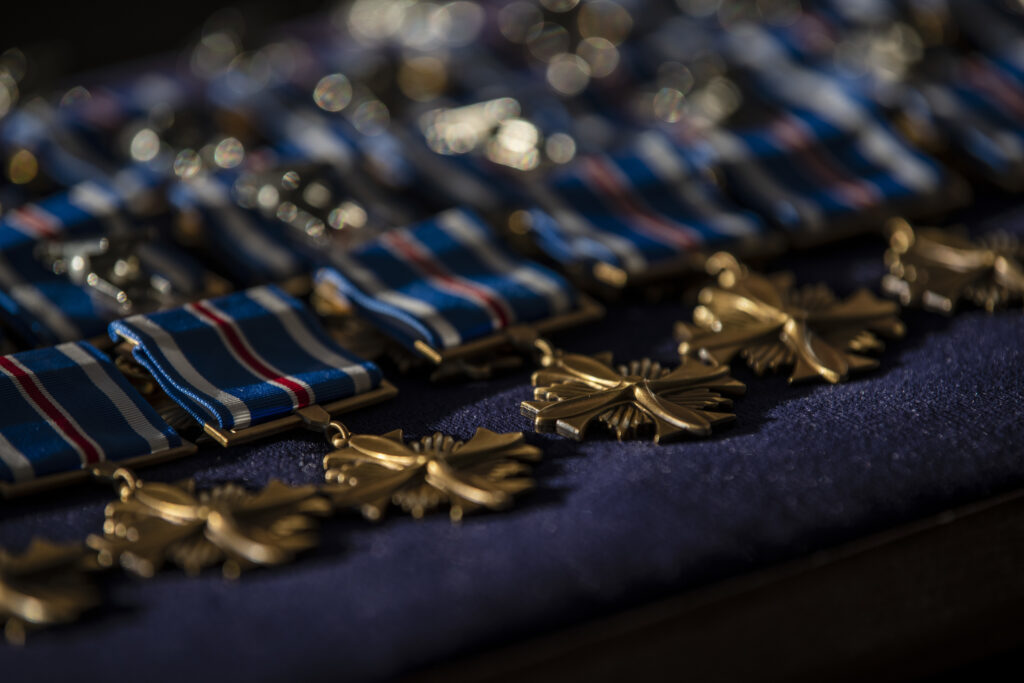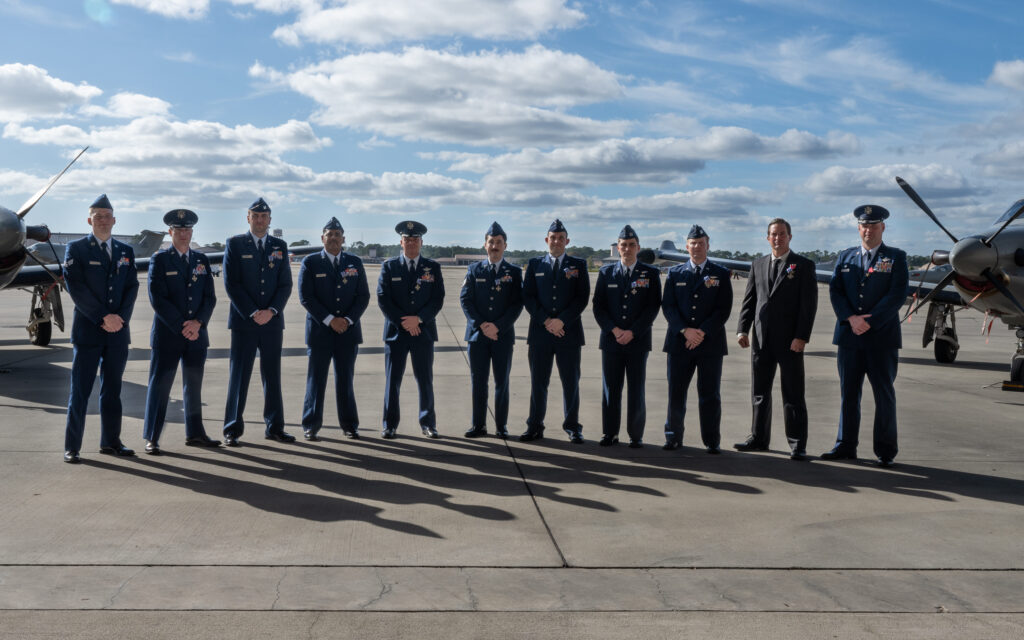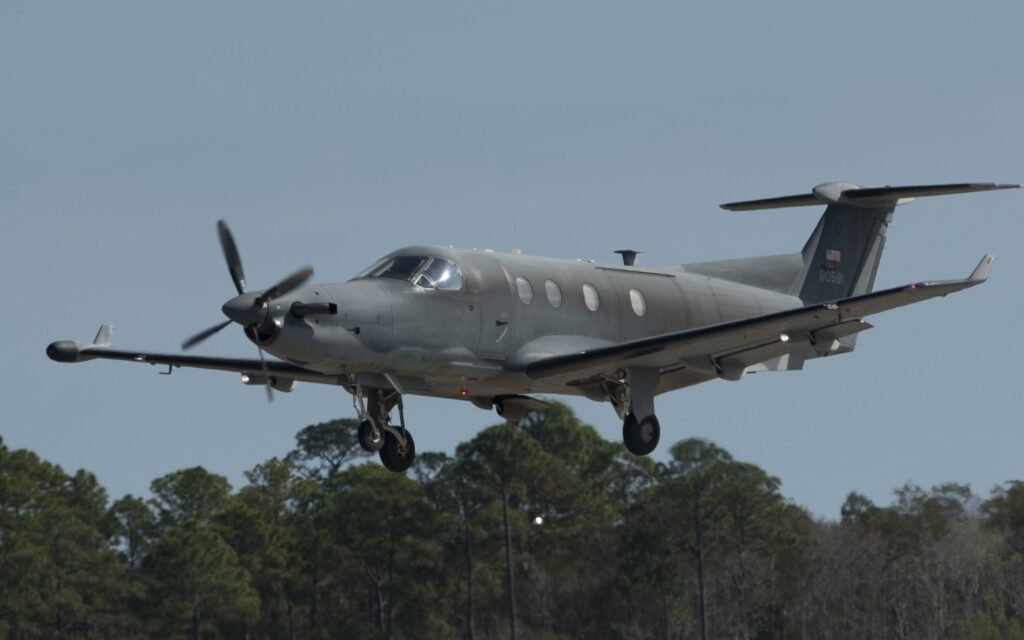
In the chaotic last days of the U.S.-led war in Afghanistan, the sound of gunfire awoke the crew of an Air Force U-28A reconnaissance plane, which quickly took off on a flight over Kabul as a nearby firefight unfolded.
The U-28A Draco flew toward the U.S. Embassy, where it would provide support for the evacuation of U.S. personnel in August 2021. Then, all of a sudden, it had to maneuver to quickly dodge under a rocket that a militant fired from the ground, the Air Force said in a statement Friday.
“It really set the tone for the rest of the flight,” said Capt. Max Arnold, a Draco pilot with the 319th Special Operations Squadron.
Arnold and other members of three Draco teams earned the Distinguished Flying Cross, the nation’s highest honor for aerial achievement, for that Afghanistan mission. They received the award at a ceremony Friday inside the Freedom Hangar at Hurlburt Field, Florida.
It’s the first time the military has awarded Distinguished Flying Cross to members of the U-28A community, which Col. Allison Black said has “lived in the shadows of recognition” for its entire existence.
“Today there are no shadows,” said Black, who commands the 1st Special Operations Wing.


What is the U-28A Draco?
The U-28A is a modified single-engine Pilatus PC-12, fixed-wing, turboprop-powered aircraft. It’s part of the Air Force Special Operations Command’s manned, airborne intelligence, surveillance, and reconnaissance fleet. The U-28A first deployed in 2006.
The light tactical aircraft’s crew consists of two pilots, one combat systems officer, and one tactical systems operator.
What is the Distinguished Flying Cross?
The Distinguished Flying Cross is awarded to any officer or enlisted person of the U.S. armed forces for heroism or extraordinary achievement while participating in aerial flight. Capt. Charles A. Lindbergh of the U.S. Army Corps Reserve was the first person to receive the Distinguished Flying Cross, earning it for his solo flight of 3,600 miles across the Atlantic Ocean in 1927 that made him a household name.
An Act of Congress on July 2, 1926, authorized the Distinguished Flying Cross. Whether awarded for heroism or achievement, it recognizes acts that must be wholly distinctive and not routine. Sustained operational activities and flights do not meet the eligibility requirements for the Distinguished Flying Cross.
The Distinguished Flying Cross medal, which Elizabeth Will and Arthur E. DuBois designed, is a bronze cross pattee with rays between the arms of the cross. A four-bladed propeller, with one blade in each arm of the cross, adorns the back side of the medal. The cross hangs from a plain shield centered on a rectangular bar.
The medal’s ribbon has a narrow red center stripe. Flanking it on either side are a thin white stripe, a wide dark blue stripes, a narrow white stripe, and a narrow dark blue stripe. Recipients of the Distinguished Flying Cross may wear Combat “C” and Valor “V” devices on the ribbon, as appropriate.
Why were the U-28A crews awarded the Distinguished Flying Cross for the first time?
The U-28A teams of Draco 42 and 43 received the Distinguished Flying Cross for their aerial achievement on Aug. 15–Aug. 16, 2021, as the Taliban retook the Afghan capital of Kabul. The U-28A teams served as “eyes in the sky” for the evacuation of the embassy and Hamid Karzai International Airport.
The three U-28A teams began the two-day mission on the morning of Aug. 15, unaware of what the day would bring. They alternated back-to-back reconnaissance sorties to provide constant intelligence, reconnaissance, and surveillance to U.S. forces over the critical first 24-hour period of the capital’s collapse and the rapid U.S. evacuation of personnel. As one crew would land, another would take off.
While many anticipated the U.S. evacuation would lead to the collapse of the NATO-supported Afghan government, it’s worth recalling that few had expected the capital to fall as quickly as it did on Aug. 15, 2021. The scenes from that day and the weeks that followed shocked the world, including images of Afghans who had rushed the Kabul airport runway clinging to U.S. cargo aircraft and falling to the ground.
The Afghanistan mission: Day 1
After its initial flight in which it dodged the rocket, the Draco 42 dayline crew landed on a recovery airfield that crowds of unidentified and armed personnel had swarmed, the Air Force said.
The relief aircraft, Draco 43 nightline, took off toward Hamid Karzai International Airport and, according to the Air Force, was forced to evade enemy anti-aircraft artillery.
As they continued the mission circling the airport searching for potential security breaches, the crew watched crowds Afghans push onto the airfield below.
“There were just packs of people,” said Capt. Nicklaus Lutz, a 319th SOS combat systems officer. “There was a lot of movement and a lot of craziness going on.”
Then the crew realized that the personnel in the air traffic control tower had fled.
“That’s not a conversation you expect to have after takeoff, especially after you’ve already been shot at,” Lutz said.
The Draco crews would help deconflict inbound air traffic—mostly C-17 Globemaster III helping evacuate thousands of fleeing Americans, Afghans, and others.
But they weren’t sure what would happen once they were back on the ground.
“One situation we thought about was that when we landed we were going to be on our own,” Lutz said.
Then a group of Marines walked out onto the airfield, arms outstretched.
“They cleared the airfield and there was a moment where we realized that we should be able to land and that we would be fine,” he said. “It dawned on us that we almost died.”
The Afghanistan mission: Day 2
Before sunrise on Aug. 16, 2021, the Draco 43 dayline crew took to the air and headed for the international airport. As they arrived to provide security information to the ground forces below, the crew saw the airfield was littered with abandoned burning vehicles and destruction.
Then the crowds of desperate Afghans descended again.
“People were piling up around the airfield, trying to flee,” said Capt. James Ryan, a 319th SOS combat systems officer. “They eventually surged past the breaking point, and all of a sudden there were thousands of people rushing the airfield.”
As Draco 43 Nightline reached critically-low fuel levels, the crew realized landing would be a challenge.
“There were just too many people on the airfield,” Ryan said. “We were lining up on the taxiway, because there was just nowhere else to land.”
Once on the ground, the crew powered down the aircraft and barricaded the doors until ground forces arrived to escort them.
The Draco crews’ mission was complete.
“It was a dire situation,” Lutz said. “There were so many variables. Getting shot at on takeoff, losing your landing base, not knowing who is hostile or who is a refugee, and then the possibility of getting shot at again. I was lucky to be on the crew I was on.”
Keep Reading
Sign up
You may eventually get a newsletter.
The Chad Garland Writes For You newsletter doesn’t exist yet, but one day it will. Possibly.
The free weekly newsletter will take no time to read, because it’ll probably just pile up in your inbox.

